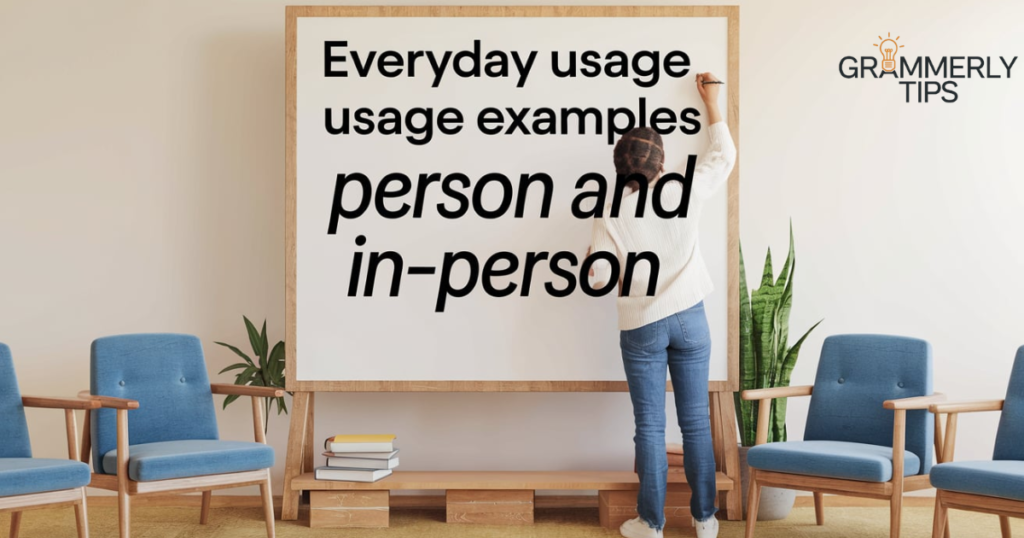English can be tricky, especially when it comes to small differences like in person or in-person. While these phrases might seem similar, they serve different purposes in writing and conversation. Knowing when to use each can improve your communication skills.
Understanding the proper usage of in person or in-person is essential for clear and professional writing. This guide will break down their meanings, examples, and when to choose one over the other. Let’s dive in.
Understanding In Person And In-Person

In Person: Definition and Usage
In person is a phrase used to describe actions done physically rather than virtually or through other means. It emphasizes being present at a location. For example, “She attended the meeting in person.”
This term highlights face-to-face interaction, often used in contrast to remote communication. It’s commonly seen in formal and casual contexts.
For Example
- I prefer to shop in person rather than online to see the products firsthand.
- He delivered his speech in person, captivating the audience with his presence.
- Meeting the author in person was a dream come true for the fans.
These examples show how “in person” emphasizes physically being present for experiences like shopping, giving speeches, or meeting someone. It contrasts with virtual or indirect interactions, highlighting personal connection and authenticity.
In-Person: Definition and Usage
In-person is an adjective used to describe events, meetings, or activities that require physical presence. It modifies nouns to emphasize face-to-face interaction. For example, “We scheduled an in-person interview.”
This term contrasts with virtual or remote alternatives. It’s commonly used in professional and formal writing to specify direct participation.
For Example
- The company is hosting an in-person workshop for new employees next week.
- Due to the pandemic, many in-person classes shifted to online formats.
- Attending the in-person event allowed us to network with industry professionals.
These examples highlight how “in-person” is used to describe events or activities requiring physical presence. It emphasizes direct, face-to-face interactions, often in contrast to virtual settings.
Click to Read: “Perform Or Preform: What’s The Difference?”What to remember In Person and In-Person
Understanding the difference between “in person” and “in-person” is simple once you remember their roles. Use “in person” as a phrase to describe actions performed physically, emphasizing presence (e.g., “I met her in person”). On the other hand, use “in-person” as an adjective to describe events or activities that require physical presence (e.g., “We attended an in-person meeting”).
The key is to focus on grammar: “in person” functions as an adverbial phrase, while “in-person” is always used before a noun. Being mindful of this distinction will ensure your writing is clear and professional.
Should You Write In-Person or In Person?
Choosing between “in-person” and “in person” depends on how the phrase is used in a sentence. Use “in-person” when describing a noun, such as in “in-person meeting” or “in-person event.” This helps clarify that the activity requires physical presence.
Use “in person” when describing the manner of an action, as in “She appeared in person to give her statement.” It functions as an adverbial phrase emphasizing the action. Paying attention to context and sentence structure will guide you in selecting the correct form.
How to Use In Person & Sentence Examples
Use “in person” when referring to physically being somewhere or performing an action face-to-face. It acts as an adverbial phrase. For example, “I prefer to speak with my clients in person.” Another example is, “He handled the situation in person rather than over the phone.”
This phrase highlights the importance of direct presence or interaction, distinguishing it from virtual or remote alternatives.
How to Use In-Person & Sentence Examples
Use “in-person” as an adjective to describe events or activities that require physical presence. It is placed before a noun to specify direct interaction. For example, “The company is holding an in-person interview next week.” Another example is, “They organized an in-person event for networking.”
This term helps emphasize the need for face-to-face participation, contrasting with virtual or remote options.
Side-by-Side Comparison: In Person vs. In-Person
| In Person | In-Person |
| Definition: Used as an adverb to describe actions performed physically or face-to-face. | Definition: Used as an adjective to describe events or activities that require physical presence. |
| Common Usage: Used when emphasizing the act of being physically present in an activity. | Common Usage: Used to describe events, meetings, or activities that involve direct interaction or physical attendance. |
| Example: I prefer to talk in person rather than over the phone. | Example: The in-person conference was a great success. |
| Key Difference: Focuses on the action of being physically present. | Key Difference: Describes the nature of an event that requires face-to-face participation. |
| Usage Tip: Typically follows verbs like “meet,” “attend,” or “speak.” | Usage Tip: Typically precedes nouns like “event,” “meeting,” or “interview.” |
The table outlines the key distinctions between “in person” and “in-person”. “In person” is used as an adverb to describe actions done face-to-face, such as meeting or speaking directly. It emphasizes the physical presence during an action.
On the other hand, “in-person” functions as an adjective, describing events or activities that require being physically present, like a meeting or conference. The key difference lies in how “in person” focuses on the action, while “in-person” highlights the event or setting requiring face-to-face participation.
Everyday Usage Examples

In Person
- I prefer to go to the doctor in person rather than using telemedicine.
- She wanted to thank her friend in person for the thoughtful gift.
- We will discuss the project in person during our meeting tomorrow.
- He decided to visit the office in person to resolve the issue.
In-Person
- The company is organizing an in-person seminar for new employees.
- She was excited to attend the in-person concert after a long wait.
- They scheduled an in-person interview for the job position.
- The school will hold an in-person graduation ceremony this year.
FAQs
Is there a hyphen in in person?
No, there is no hyphen in “in person” when used as an adverb. It’s written as two separate words.
What is the difference between in person and in-person?
“In person” is an adverb describing the action of being physically present, while “in-person” is an adjective describing events or activities requiring physical presence.
How do you say meeting in person?
When referring to a meeting that requires physical presence, you say “meeting in person,” emphasizing the face-to-face interaction.
Is person to person hyphenated?
Yes, “person-to-person” is hyphenated when used as an adjective, such as in “person-to-person communication.”
Conclusion
In conclusion, understanding when to use “in person” and “in-person” is crucial for clear and effective communication. “In person” is used as an adverb to emphasize the action of being physically present, while “in-person” serves as an adjective to describe events or activities that require direct participation.
Paying attention to these distinctions helps ensure proper grammar and enhances the clarity of your writing. Always consider the context and structure of the sentence to determine which form is appropriate. By mastering these subtle differences, you can improve both your writing and spoken communication.

Grammerlytips.com, authored by Jame, offers expert tips and insights on mastering grammar, enhancing writing skills, and boosting communication effectiveness.

